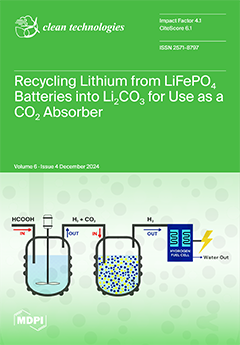The growing adoption of lithium iron phosphate (LiFePO
4) batteries in electric vehicles (EVs) and renewable energy systems has intensified the need for sustainable management at the end of their life cycle. This study introduces an innovative method for recycling lithium from spent LiFePO
4 batteries and repurposing the recovered lithium carbonate (Li
2CO
3) as a carbon dioxide (CO
2) absorber. The recycling process involves dismantling battery packs, separating active materials, and chemically treating the cathode to extract lithium ions, which produces Li
2CO
3. The efficiency of lithium recovery is influenced by factors such as leaching temperature, acid concentration, and reaction time. Once recovered, Li
2CO
3 can be utilized for CO
2 capture in hydrogen purification processes, reacting with CO
2 to form lithium bicarbonate (LiHCO
3). This reaction, which is highly effective in aqueous solutions, can be applied in industrial settings to mitigate greenhouse gas emissions. The LiHCO
3 can then be thermally decomposed to regenerate Li
2CO
3, creating a cyclic and sustainable use of the material. This dual-purpose process not only addresses the environmental impact of LiFePO
4 battery disposal but also contributes to CO
2 reduction, aligning with global climate goals. Utilizing recycled Li
2CO
3 decreases the demand for virgin lithium extraction, supporting a circular economy. Furthermore, integrating Li
2CO
3-based CO
2 capture systems into existing industrial infrastructure provides a scalable and cost-effective solution for lowering carbon footprints while securing a continuous supply of lithium for future battery production. Future research should focus on optimizing lithium recovery methods, improving the efficiency of CO
2 capture, and exploring synergies with other waste management and carbon capture technologies. This comprehensive strategy underscores the potential of lithium recycling to address both resource conservation and environmental protection challenges.
Full article





